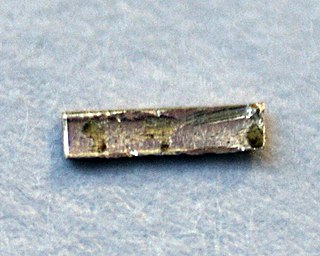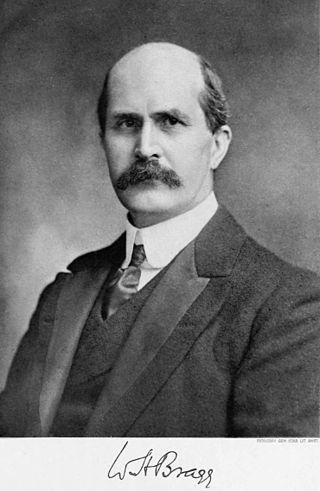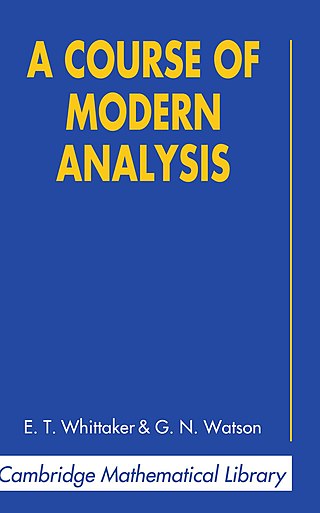
In chemistry, cyanide is a chemical compound that contains a C≡N functional group. This group, known as the cyano group, consists of a carbon atom triple-bonded to a nitrogen atom.

Frederick Soddy FRS was an English radiochemist who explained, with Ernest Rutherford, that radioactivity is due to the transmutation of elements, now known to involve nuclear reactions. He also proved the existence of isotopes of certain radioactive elements. In 1921 he received the Nobel Prize in Chemistry "for his contributions to our knowledge of the chemistry of radioactive substances, and his investigations into the origin and nature of isotopes". Soddy was a polymath who mastered chemistry, nuclear physics, statistical mechanics, finance and economics.

Radium is a chemical element; it has symbol Ra and atomic number 88. It is the sixth element in group 2 of the periodic table, also known as the alkaline earth metals. Pure radium is silvery-white, but it readily reacts with nitrogen (rather than oxygen) upon exposure to air, forming a black surface layer of radium nitride (Ra3N2). All isotopes of radium are radioactive, the most stable isotope being radium-226 with a half-life of 1,600 years. When radium decays, it emits ionizing radiation as a by-product, which can excite fluorescent chemicals and cause radioluminescence. For this property, it was widely used in self-luminous paints following its discovery. Of the radioactive elements that occur in quantity, radium is considered particularly toxic, and it is carcinogenic due to the radioactivity of both it and its immediate decay product radon as well as its tendency to accumulate in the bones.
The year 1915 involved numerous significant events in science and technology, some of which are listed below.

Sir William Henry Bragg was an English physicist, chemist, mathematician, and active sportsman who uniquely shared a Nobel Prize with his son Lawrence Bragg – the 1915 Nobel Prize in Physics: "for their services in the analysis of crystal structure by means of X-rays". The mineral Braggite is named after him and his son. He was knighted in 1920.
Gold cyanidation is a hydrometallurgical technique for extracting gold from low-grade ore by converting the gold to a water-soluble coordination complex. It is the most commonly used leaching process for gold extraction. Cyanidation is also widely used in the extraction of silver, usually after froth flotation.
John MacArthur or Macarthur may refer to:

Sir Arthur Harden, FRS was a British biochemist. He shared the Nobel Prize in Chemistry in 1929 with Hans Karl August Simon von Euler-Chelpin for their investigations into the fermentation of sugar and fermentative enzymes. He was a founding member of the Biochemical Society and editor of its journal for 25 years.
Ralph Allan Sampson FRS FRSE LLD was a British astronomer.

Gold extraction is the extraction of gold from dilute ores using a combination of chemical processes. Gold mining produces about 3600 tons annually, and another 300 tons is produced from recycling.
The Merrill–Crowe Process is a separation technique for removing gold from the solution obtained by the cyanide leaching of gold ores. It is an improvement of the MacArthur-Forrest process, where an additional vacuum is managed to remove air in the solution, and zinc dust is used instead of zinc shavings.

A Course of Modern Analysis: an introduction to the general theory of infinite processes and of analytic functions; with an account of the principal transcendental functions is a landmark textbook on mathematical analysis written by Edmund T. Whittaker and George N. Watson, first published by Cambridge University Press in 1915. The first edition was Whittaker's alone, but later editions were co-authored with Watson.

James Walter Douglas was a British North America born mining engineer and businessman who introduced a number of metallurgical innovations in copper mining and amassed a fortune through the copper mining industry of Bisbee, Arizona Territory and Sonora before and after the turn of the 20th century.

William Duane was an American physicist who conducted research on radioactivity and X-rays and their usage in the treatment of cancer. He developed the Duane-Hunt Law and Duane's hypothesis. He worked with Pierre and Marie Curie in their University of Paris laboratory for six years and developed a method for generating quantities of radon-222 "seeds" from radium for usage in early forms of brachytherapy.

Sir George Thomas Beilby was a British chemist.
Sir Johannes John Wilhelmus Wessels (1862–1936) was an Afrikaner judge of the Appellate Division from 1923 to 1936 and Chief Justice of South Africa from 1932 to 1936.
The Standard Chemical Company (SCC) of Canonsburg, Pennsylvania, was the first successful commercial producer of radium. SCC operated the radium refining mill from 1911 to 1922 on a 19-acre (77,000 m2) plot of land. The company supplied radium to the United States Radium Corporation for use in their watch dials.
Loch Lomond Radium Works was a company founded by John Stewart MacArthur in 1911 as the Radium Works in Halton, Cheshire, England. The company moved to Balloch, West Dunbartonshire, Scotland in 1915. The company produced radium for use in medicine and for radioluminescent paint until it was closed down in 1927.










